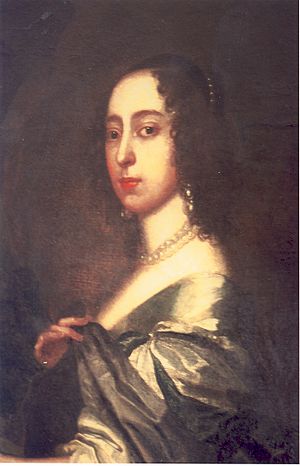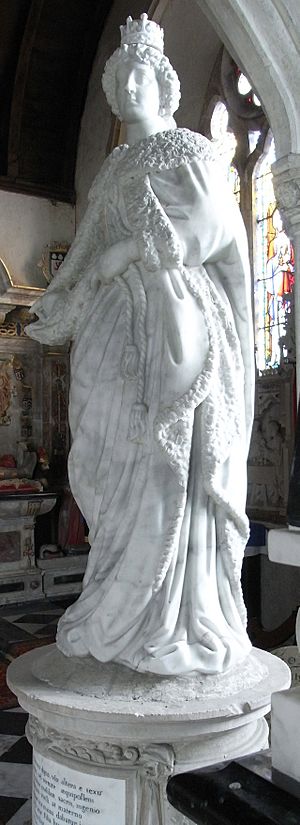Rachel Bourchier, Countess of Bath facts for kids
Rachel Bourchier, Countess of Bath (born Fane; 28 January 1613 – 11 November 1680) was an important English noblewoman and writer. She was married to Henry Bourchier, 5th Earl of Bath. Rachel is most famous for what she did during the English Civil War.
Contents
Early Life and Family
Rachel Fane was born on January 28, 1613, at Mereworth Castle in Kent, England. She was the fifth daughter of Francis Fane, 1st Earl of Westmorland and his wife, Mary Mildmay. Rachel grew up at Apethorpe Hall in Northamptonshire.
Her brother, Mildmay Fane, 2nd Earl of Westmorland, was a poet and writer. He was good friends with King Charles I. The King even became a godfather to Mildmay's son. Another of Rachel's brothers, Colonel George Fane, also supported the King during the Civil War.
Youthful Writings
When she was young, Rachel Fane enjoyed writing plays called masques. These were special performances for her family's parties and events. One of her plays was called the "May Masque," which might have been for Christmas or a Twelfth Night celebration. Another was known as the "Wishing Chair Entertainment."
Her "May Masque" included parts about country life. It likely used props from the farms on the Apethorpe estate. These plays were probably performed in the Long Gallery or the Great Hall at Apethorpe.
Around the same time she wrote her plays, Rachel also translated a part of a French story called Amadis de Gaul. Some of her notebooks and this translation are still kept today at the Kent History and Library Centre in Maidstone.
Her Marriages
First Marriage to Henry Bourchier
On December 13, 1638, when Rachel was 25, she married Henry Bourchier, 5th Earl of Bath. He was 50 years old and lived at Tawstock Court in Devon. Their wedding took place at the church of St Bartholomew the Great in the City of London.
During the English Civil War, which began around 1642, Henry Bourchier supported the King. He wrote letters to Rachel from York and London, telling her how the war was going. In 1642, a group called the House of Lords ordered someone to return horses that had been taken from Rachel.
Rachel and Henry did not have any children together. However, in 1663, Rachel became the guardian for her nephew, Sir Henry Fane. He was the only child of her brother George.
After Henry Bourchier passed away in 1654, Rachel ordered a special monument to remember him. This monument is still in St Peter's Church in Tawstock. It is made of black and white marble. It has four dogs holding up a stone coffin, with a tall, thin stone pillar at each corner.
Second Marriage to Lionel Cranfield
Six months after her first husband died, Rachel married Lionel Cranfield, 3rd Earl of Middlesex. He was 12 years younger than her, born in 1625. Lionel was a special attendant to King Charles II.
This second marriage was not a happy one. Rachel and Lionel started living apart in 1661. After Lionel passed away in 1674, Rachel did not marry again.
Memorials and Portraits
A life-size white marble statue of Rachel Fane is located in St Peter's Church in Tawstock. It was carved by Balthasar Burman. This statue is a copy of an earlier statue of Mary Cavendish.
The famous painter Sir Anthony van Dyck painted two portraits of Rachel. One was painted before her first marriage and still exists today. The other was painted in 1641, but only an engraving of it remains. A small portrait of Rachel, called a miniature, painted by David des Granges, is kept at the Fitzwilliam Museum, Cambridge.
In a book from 1670 by Sir Kenelm Digby, there is a recipe for a sweet drink called syllabub. This recipe is said to have come from Rachel, the Countess of Bath.



